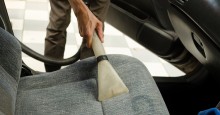
Odor and molds are genuine concerns in vehicles year-round, but when the cold weather starts to set in, they can cause unique problems for drivers.
Constant exposure to the elements and moisture, not only in the interior but also in the vehicle’s systems, can lead to serious issues for your car and potentially your own health.
What’s that smell?
If you have lived in cold climates for any length of time, you have probably gotten into a car and come across that musty smell.
This can especially be true with older models or vehicles stored outside during winter weather. These strange odors can be caused by a number of different issues.
One common source during winter is moisture collecting in the air conditioning and vent system. Since it isn’t being used regularly, this moisture can lead to a stale smell and if untreated begin to grow mold.
Sometimes, if you run your AC for a mile or more on high, it may clear out the system. If the smell persists or quickly returns, you may have a more serious issue such as a leak or clog. If this is the case, visit your mechanic so they can take a closer look at the situation.
It’s also possible the smell is coming from your cabin air filter. They get dirty and musty and should be replaced regularly. According to the experts at Automotive Service Association, filters carry mold, as well as dust and pollen which can aggravate allergies and respiratory issues.
Replacing the cabin air filter will help keep your air clean and healthy, and will improve the performance of your heating and AC, as well as defogging capabilities. You should replace your cabin air filter every 12 months or 12,000 miles, or sooner if you notice smells or even debris flying into the interior when you turn on the vents.

Passenger cabin issues
Your car might not be the smelly culprit–it could be the driver’s doing.
If you eat or drink in your car (or have someone who does), food or liquid might have dropped under a seat or in the crevices of the interior. Unseen, it could have developed mold which is causing the offending smell. Also, food smells can be absorbed in vehicle fabrics which may add to the offending odors.
If your car was involved in a flood and water got into the vehicle, even though you think it might have dried out, you could be suffering from mold. Floorboards and carpets, especially in older models, might have soaked it up and begun to develop mold.
Water may have worked its way into what should be sealed compartments containing wiring and circuitry, causing major electrical issues in addition to smells.
Do you keep wet clothes or sweaty gym gear in your car?
That could be the source. And if the items are in contact with your vehicle fabrics or carpets, they can transfer moisture and germs and quickly become a bigger problem.
The enemy: mold
With over 100,000 different species, mold can come in many forms and colors.

While most people think that molds need warm environments to flourish, they have evolved to be able to live and grow in numerous climates, including the cold and your car.
Be aware, mold can begin to grow within 24 hours of exposure to moisture. Mold can ruin your car’s interior and can lead to health issues.
If it happens to be the dreaded toxic mold, this can be a very serious problem that leads to vomiting, bleeding in the lungs, and fatigue, just for starters. This is especially concerning for people with compromised immune systems or a history of respiratory issues.
Mold can come in many colors including black, which is often the most feared of the molds. People automatically flinch when they hear about it.
While not all black mold is toxic, some strains that can be dangerous enough to cause major health problems and even death.
Yellow and green mold are among the common colors also seen. These and others can be potentially toxic. All molds should be taken seriously and cleaned as quickly and thoroughly as possible.
If you are concerned about what mold you may be dealing with or exposed to, there are numerous test kits available.
Basic testing kits allow you to identify that mold is present while more technical tests will identify the species and toxicity levels. Kits are available at hardware stores and online.
Prevent smells and mold
See the tips below to help prevent interior mold and smells from overcoming your vehicle.
- If possible, park your car in a garage or other enclosed structure when not in use. This will go a long way to help in exposure to the elements and moisture.
- Look for leaking areas that might allow moisture to enter the vehicle. Check the seals on the doors and windows. Have leaky areas repaired immediately.
- If you have a convertible, make sure the roof is closing properly, isn’t damaged and liquid isn’t trapped in the top system.
- Run the air conditioning occasionally during cold weather to move air through the system and dry it out.
- Make sure your doors and windows are securely closed when not in the car.
- Don’t eat and drink in the vehicle. If you do, be careful that no food or drink is dropped to the floor or other places. Immediately clean any spills.
- Make sure floor mats aren’t wet after tracking in snow, mud and rain. Take them out and clean them if necessary, and don’t return them until they are completely dry. Waterproof mats are a good option for inclement weather.
- Wipe down and clean the interior of your vehicle regularly.
- Be careful what you store in the car. Sweaty workout clothes, wet towels or other musty items should be removed and stored elsewhere.
- If you are a thrift shopper, be vigilant of objects that you bring home. Do not store them in the vehicle long-term and consider keeping them sealed until you can remove and sanitize them.
- Installing waterproof mats instead of carpet can go a long way to prevent mold. You still need to clean them because water and mold can become trapped in the crevices and troughs.
- Be careful of using air fresheners and sprays to simply mask the smell. If you don’t find the cause and eliminate it, you can have underlying issues that can destroy your interior and potentially affect your health.
Interior cleaning tips
Mike Pennington of Meguiar’s car care products had the following suggestions for keeping your interior clean.
For carpet and cloth materials:
- Remove spill or grime with a cotton terry cloth towel. Make sure it does not sit for hours before cleaning. Fluid tends to soak underneath materials and make your vehicle smell like a locker room.
- Use a stiff nylon brush to straighten and separate carpet or upholstery fibers to eliminate matted fibers. This process helps prevent stiff and unattractive upholstery.
- Remove coarse grime by vacuuming first before applying cleaning solutions. Just spraying the surface can turn carpet dirt into mud.
- Now use a cleaning solution, but spray it on lightly. Avoid soaking the surface.
- Agitate the area again using a clean brush.
- Finally, dab the area using a clean terry cloth towel.
The process transfers stains and potential mold-causing agents into the terry cloth towel. Make sure not to oversaturate the area or you could actually cause mold, fungus and bacterial growth.
For rubber materials:
- Remove soil and grime.
- Wipe down the area with all-purpose cleaning wipes or quick detailing solutions made for auto interiors.
- Apply a rubber treatment. Cleaners may strip rubber material of its protection. Some cleaning products provide a coating of UV protection as well. If not, apply a separate coat of rubber protection to help keep the material soft and pliable.
For leather and vinyl, look for wipes or sprays made specifically for those surfaces:
- Use a terry cloth towel to clean off the surface.
- Spray cleaner on a terry cloth towel then wipe down leather and vinyl surfaces. The process helps prevent overspray, which becomes a dirt magnet.
- Use a leather and vinyl reconditioner to keep surfaces healthy. Otherwise, the process is tantamount to washing hands with a harsh detergent.
- Make sure to use products designed for the specific vehicle surface. Read the directions and use the right tools.
Copyright © 2024 by Sensible Driver. All rights reserved.